Sexism has always been used to convince consumers to buy a product so we that women can strive to fulfil the idealised images that advertisers present us with. It Is the norm for advertisements to contain explicit images of the female body. The 1970’s Tipalet campaign and 2011 Lynx campaigning both sexualise women in their ads. Both brands are selling sex. Consumers are buying into the desire to fulfil the image in the ad and have an emotive response to the women in the images. Using explicit images of women in adverts changes societies view of femininity. Young girls and women will deem the content of these adverts the perfect female form. Thus furthering that the sexualising of woman does not always have the desired effect and can have a negative impact rather than empowering.

Tipalet ad 1970’s
Imagery from the 1970s’ such at the Tipalet cigarette poster saw the increase in seductive photography used to sell products to men. The poster shows a woman gazing into the mans eyes. It is fair to suggest from this gaze that the woman looks sexually aroused. “Seeing a face anticipating orgasm, even if it is staged, is a powerful sell” [1]The advert tells the male consumers that smoking this type of cigarette will attract women, in turn the male smoking will become a sexual magnet and the woman a sexual object once purchasing Tipalet. Furthermore, the contemporary 2011 Lynx campaign shows how seductive photography is still rife in advertising. The model is holding her breasts with a seductive smile. Similarly, the 1970’s Tipalet ad these features also imitate sexual arousal. On the whole Lucy Pinder (glamour model) is objectified, she is merely seen as a ‘piece of meat’, focusing on her breasts, legs, mouth and other features. It is evident that advertisers have not stopped sexualising women for their campaigns; exemplifying Pinders’ body and sexuality only.

Outdoor ad for Lynx Excite 2011
The sexualisation of women in advertisements has led to the distortion of femininity. Both the 1970s’ Tipalet and the 2011 campaign use very attractive woman in their work. Large breasts, sexuality and beauty seen in these adverts generate success and happiness making them the ideal form of a woman. Many young girls and women are aspiring the look like the girls in campaigns, often go to extreme lengths to reach their goals such as cosmetic surgery or going on diets. “The number of people diagnosed with eating disorders has increased by 15 per cent since 2000’’ females are bombarded with these images to such an extent that they then create pressure for themselves to look that way often causing self esteem and health issues. “The number of people diagnosed with eating disorders has increased by 15 per cent since 2000’’[1]It is interesting to note that the Lynx advert drew ‘113 complaints.’[2] Complaints show that women don’t see themselves as sexual objects. Unilever’s Lynx brand has been hit with a double ban for separate outdoor and internet campaigns after the advertising watchdog upheld complaints that they objectified women”[3] the fact that this advertisement was banned and has so many complaints whereas the 1970’s advert was not banned suggests that society’s view of a woman has changed and that equality is more prevalent. The modern woman’s stance within society means that they are less accepting of said advertisements.
Overall, sexualisation of women in advertisements sells products. Consumers buy into the idealised images advertisers present. Through the bombardment of explicit images of the body it has become the norm for Women to undergo surgeries to enhance their feminine attributes. Therefore, consumers do not now recognise these images as being objectifying.
[1] Micali, N. et al “The incidence of eating disorders in the UK in 2000-2009; findings from the General Practice Research Database”
[2] http://www.campaignlive.co.uk/article/lynx-ads-banned-degrading-women-reaching-kids/1105465
[3] http://www.campaignlive.co.uk/article/lynx-ads-banned-degrading-women-reaching-kids/1105465
[4] Wolf, N (1991) The Beauty Myth: How Images of Beauty are Used Against Women. Vintage. 131-147